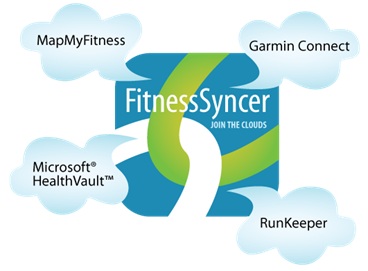Welcome FitnessSyncer! (AKA Why ecosystems are awesome)
 The important part of this post
The important part of this post
Woo Hoo! US-based users have a great new option for connecting fitness data to HealthVault --- go check out FitnessSyncer for a free account to integrate information from:
- Garmin Connect
- MapMyFitness (And all the “MapMyFoo” sites: Ride, Run, Walk, Hike, etc.)
- RunKeeper
This is super-awesome and opens up data that we’ve wanted to link for a long time. Garmin makes beautiful fitness equipment, and both MapMyFitness and RunKeeper have justifiably loyal followings thanks to superb mobile integrations.
Now that great stuff can be part of a larger story --- for correlation, for sharing with friends and caregivers, or for using in other great apps, especially if you’re working on an exercise program to improve heart health or another chronic condition (if that’s you, check out Heart360).
The geeky part of this post
I have a sequence of slides I use to illustrate how critical the ecosystem is to scalable innovation in the healthcare world (e.g., check out slides 4-10 from my HIMSS NW talk just the other day). “Ecosystem” is just a fancy word I over-use to mean our community --- vendors, users, providers, advocates, payers, governments, etc. etc. etc. --- all of us that have some stake in and add some value towards the goal of BETTER care for MORE people for LESS money.
Nobody can reach this goal on their own; the evidence for that is everywhere. We have to collaborate. But if we’re going to do that effectively, the environment has to support it. There are tons of facets to that support (payment incentives, anyone?) --- but the one I’ve chosen to attack is technology. How can we create an environment where technology supports integration and collaborative problem solving?
That is what the HealthVault API does. It puts the individual/patient in the center of collaborative problem solving --- so that everybody in the care network can have the right information, at the right time, regardless of the technology they use or where they fit into the overall system.
Even more importantly, it does this in a LOOSELY COUPLED way. “Loose coupling” is a term we use to mean that each component can be built, deployed, improved and changed without impacting the others. This lets us break down problems into smaller pieces that independent groups CAN solve on their own, and then contribute back to the whole.
FitnessSyncer is a great example of this. I’ve wanted to connect HealthVault to Garmin equipment since the day we launched in 2007. But I have a bunch of stuff going on. And the Garmin folks have a lot going on. And frankly, other priorities always seemed just a little more urgent --- so five years later, still no connection.
Enter Eric and the team at FitnessSyncer. They identified that there was a market opportunity and set out to deliver on it. They built on the open, loosely-coupled interfaces that HealthVault and Garmin expose for developers, and were off to the races. They didn’t even TELL us they were doing anything until they had to flip the switch to go live! So the heck with MY priorities --- the ecosystem was able to solve this problem better, faster and cheaper than I could.
THIS IS INCREDIBLE GOODNESS --- and something we see happening every day. When an employee wellness program can get access to dozens of home monitoring devices thanks to one HealthVault connection. When an innovative post-discharge regimen becomes available to a bunch of EMRs all at once thanks to Direct Project messaging. When data structures created by one payer can accelerate the progress of an industry-wide movement. It is just exhilarating.
So what’s the point of all this? Just a plea, really --- be a part of our growing and accelerating healthcare ecosystem --- not a new silo. HealthVault can help you be better faster, and I’m betting you can do the same for us. So take a look --- it’s all out there on MSDN. Or just use the contact form on this page to ask me a question --- as my team will tell you, I’m a sucker for a good idea.